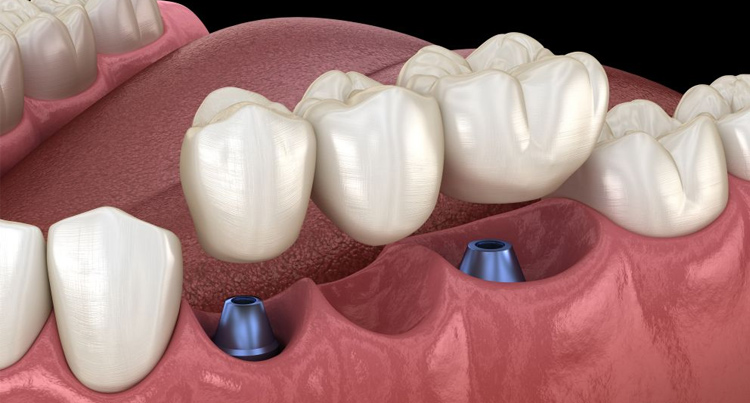Dental Crowns and Bridges
Crowns and bridges are a fixed solution to missing or damaged teeth. This restorative procedure uses prosthetic devices to return your smile to its natural state. A crown is used when the tooth structure is damaged or fractured. A bridge is used when one or more teeth are missing.

What is a crown?
A crown is basically a manufactured tooth. It’s generally made of porcelain or ceramic that can be colour and texture-matched to your existing teeth. A crown can also be made of gold alloys for improved strength when replacing a back tooth. Often a metal crown will have porcelain bonded to the exterior to give it strength and a natural look.
How is a crown fitted?
Crowns are used when an existing tooth is damaged, fractured or weakened. The tooth is filed down and reshaped into a smaller size. Any decay is removed and the tooth structure is prepared to support the crown. The crown fits like a cap over the newly shaped tooth and is cemented into position.
What is a bridge?
Bridges are commonly used to replace one or more missing teeth. They span the space where the teeth are missing. Gaps left by missing teeth eventually cause the remaining teeth to rotate or shift into the empty spaces, resulting in a bad bite. The imbalance caused by missing teeth can also lead to gum disease and temporomandibular joint (TMJD) disorders.
How is a bridge fitted?
A bridge consists of false teeth rigidly attached between two crowns. The teeth on either side of the gap are prepared for these crowns and the bridge is cemented into place. In some cases, it’s possible to use implants to replace the missing teeth rather than using the existing teeth. Once a bridge is cemented into position, it looks and works just like natural teeth.
When is a crown or bridge required?
Crowns and bridges are used to repair a number of different dental problems.
A crown can be used when:
- a tooth is fractured or damaged
- too much decay has weakened a tooth
- a tooth is severely discoloured
- a tooth is misshaped
- a dental bridge needs an anchor.
A bridge is used to replace a missing tooth or teeth. It is also a possible solution when dentures are unstable, uncomfortable or aesthetically displeasing.
How Long Does The Procedure Take?
The treatment procedure usually takes two appointments. At your first appointment:
- your tooth/teeth will be prepared and shaped for the crown/bridgework.
- A 3D digital scan will be taken of your teeth so that a laboratory can custom-create your dental crown/bridge.
- A temporary crown/bridge is made to protect the tooth/teeth and keep you smiling.
Your second appointment is usually two to three weeks later to ensure the laboratory has time to meticulously create your crown or bridgework. At this second appointment your crown or bridge will be cemented into place.
Crown and bridge care
Once your crown or bridge is fitted, it’s important to maintain a regular and effective routine of oral hygiene. Brush and floss at least twice a day, taking extra care to floss around your crown. This will help avoid decay where the crown and the tooth join. Avoid sticky foods such as toffee and lollies, and do not use your teeth inappropriately – chewing pens, crunching ice, gnawing fingernails, etc.
A dental floss threader, which looks like a small bendy brush, can be used to clean under your bridge. There are also water jets on the market that will help keep your bridge clean.
Whether you have a crown or a bridge, the most important thing is to regularly visit your dentist for a check-up and clean.
How long will a bridge or crown last?
How long your crown and bridge lasts will depend on the effectiveness and regularity of your dental hygiene routine. They usually last between 7-15 years, but longer periods are certainly possible with outstanding oral hygiene and regular dental check-ups.
*Any surgical or invasive procedure carries risks. Before proceeding, you should seek a second opinion from an appropriately qualified health practitioner.

